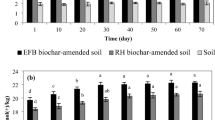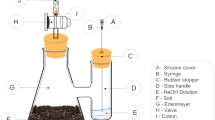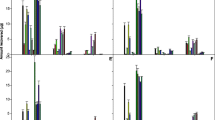Abstract
This study evaluated the remobilization, mineralization, and metabolism of herbicide-bound residues in soils amended with various types of sugarcane waste. Soil with bound residues of three herbicides and fresh soil samples were added to the biometric flasks, followed by the addition of vinasse, filter cake, or sugarcane straw in order to reactivate the microbial activity. In sandy loam soil, higher mineralization was observed where filter cake was added, and the maximum mineralized percentage was 7.7, 46.7, and 8.1% of diuron-, hexazinone-, and metribuzin-bound residues, respectively. Conversely, this soil presented a greater percentage of re-extractable hexazinone and metribuzin residues when vinasse was added. Among the examined herbicides, a higher percentage of bound metribuzin residues remained in the soil (57.5–75.6%). It was possible to identify both metabolites and parent compounds in the re-extracted residues, implying either species could bind to the soil. Therefore, this study has shown that bound residues of three herbicides and their metabolites can become bioavailable, and mineralized or returned to the soil solution, which could adversely affect subsequent crops or non-target organisms. Hence, the remobilization of bound residues must be taken into account when assessing the environmental risk of herbicides in soils in registration processes.






Similar content being viewed by others
References
Andreia, M.M., and F.M. Wiendl. 1995. Formation and biorelease of bound residues of pesticides in two Brazilian soils:1—[14C]-lindane. Pesquisa Agropecuária Brasileira 30(5): 687–694.
Arias-Estévez, M., E. López-Periago, E. Martínez-Carballo, J. Simal-Gándara, J.C. Mejuto, and L. García-Río. 2008. The mobility and degradation of pesticides in soils and the pollution of groundwater resources. Agriculture, Ecosystems & Environment 123(4): 247–260.
Barriuso, E., P. Benoit, and I.G. Dubus. 2008. Formation of pesticide nonextractable (bound) residues in soil: Magnitude, controlling factors and reversibility. Environmental Science and Technology 42: 1845–1854.
Cabrera, A., L. Cox, P. Velarde, W.C. Koskinen, and J. Cornejo. 2007. Fate of diuron and terbuthylazine in soils amended with two-phase olive oil mill waste. Journal of Agricultural and Food Chemistry 55(12): 4828–4834.
Companhia Ambiental do Estado de São Paulo-CETESB. 2015. P4.231: Stillage: Criteria and Procedures for Agricultural Soil Application. São Paulo, Brazil: CETESB.
Christofoletti, C.A., J.P. Escher, J.E. Correia, J.F.U. Marinho, and C.S. Fontanetti. 2013. Sugarcane vinasse: Environmental implications of its use. Waste Management 33(12): 2752–2761.
Dalton, R.L., A.W. Evans, and R.C. Rhodes. 1966. Disappearance of diuron from cotton field soils. Weeds 14(1): 31–33.
El Sebaï, T., M. Devers-Lamrani, B. Lagacherie, N. Rouard, G. Soulas, and F. Martin-Laurent. 2010. Isoproturon mineralization in an agricultural soil. Biology and Fertility of Soils 47(4): 427–435.
Ellegaard-Jensen, L., B.E. Knudsen, A. Johansen, C.N. Albers, J. Aamand, and S. Rosendahl. 2014. Fungal–bacterial consortia increase diuron degradation in water-unsaturated systems. Science of the Total Environment 466–467: 699–705.
Führ, F., H. Ophoÿ, P. Burauel, U. Wanner, and K. Haider. 1998. Modification of the definition of bound residues. In Pesticide bound residues in soil. Senate Commission for the Assessment of Chemicals used in Agriculture, 175–176. Berlin: Wiley-VCH.
Giacomazzi, S., and N. Cochet. 2004. Environmental impact of diuron transformation: A review. Chemosphere 56(11): 1021–1032.
Guimarães, A.C.D., K.F. Mendes, F.C. Reis, T.F. Campion, P.J. Christoffoleti, and V.L. Tornisielo. 2018. Role of soil physicochemical properties in quantifying the fate of diuron, hexazinone, and metribuzin. Environmental Science and Pollution Research 25(13): 12419–12433.
Hassuani, S. 2005. Biomass power generation: Sugarcane bagasse and trash. In Série Caminhos para Sustentabilidade, ed. S. Hassuani, M. Leal, and I. Macedo, 1–217. Piracicaba: PNUD-CTC.
Karanasios, E.C., N.G. Tsiropoulos, and D.G. Karpouzas. 2013. Quantitative and qualitative differences in the metabolism of pesticides in biobed substrates and soil. Chemosphere 93(1): 20–28.
Kasozi, G.N., P. Nkedi-Kizza, S. Agyin-Birikorang, and A.R. Zimmerman. 2010. Characterization of adsorption and degradation of diuron in carbonatic and noncarbonatic soils. Journal of Agricultural and Food Chemistry 58(2): 1055–1061.
Khoury, R., A. Geahchan, C.M. Coste, J.F. Cooper, and A. Bobe. 2003. Retention and degradation of metribuzin in sandy loam and clay soils of Lebanon. Weed Research 43(4): 252–259.
Kjær, J., P. Olsen, T. Henriksen, and M. Ullum. 2005. Leaching of metribuzin metabolites and the associated contamination of a sandy Danish aquifer. Environmental Science and Technology 39: 8374–8381.
Lalah, J.O., B.M. Muendo, and Z.M. Getenga. 2009. The Dissipation of hexazinone in tropical soils under semi-controlled field conditions in Kenya. Journal of Environmental Science and Health Part B 44(7): 690–696.
Liu, J., Y. Wang, B. Jiang, L. Wang, J. Chen, H. Guo, and R. Ji. 2013. Degradation, metabolism, and bound-residue formation and release of tetrabromobisphenol A in soil during sequential anoxic–oxic incubation. Environmental Science and Technology 47(15): 8348–8354.
Locke, M.A., and S.S. Harper. 1991. metribuzin degradation in soil: II-effects of tillage. Pesticide Science 31(2): 239–247.
Lourencetti, C., M.R.R. Marchi, and M.L. Ribeiro. 2012. Influence of sugar cane vinasse on the sorption and degradation of herbicides in soil under controlled conditions. Journal of Environmental Science and Health Part B 47(10): 949–958.
Marinho, D.A., S.T. Bicalho, and E.M. Ferreira. 2012. Distribution and mineralization of 14C-hexazinone in soil-plant microcosm with the riparian forest specie Cecropia hololeuca. Journal of Bioremediation and Biodegradation 1: 10–15.
Moretto, J.A.S., J.P.R. Furlan, A.F.T. Fernandes, A. Bauermeister, N.P. Lopes, and E.G. Stehling. 2019. Alternative biodegradation pathway of the herbicide diuron. International Biodeterioration and Biodegradation 143(2019): e104716.
Munier-Lamy, C., M.P. Feuvriera, and T. Chonéb. 2002. Degradation of 14C-atrazine bound residues in brown soil and rendzina fractions. Journal of Environmental Quality 31(1): 241–247.
Mutua, G.K., A.N. Ngigi, and Z.M. Getenga. 2016. Degradation characteristics of metribuzin in soils within the Nzoia river drainage basin, Kenya. Toxicological and Environmental Chemistry 7: 800–813.
Nowak, K.M., A. Miltner, M. Gehre, A. Schäffer, and M. Kästner. 2011. Formation and fate of bound residues from microbial biomass during 2,4-D degradation in soil. Environmental Science and Technology 45(3): 999–1006.
Organisation for Economic Co-operation and Development-OECD. 2002. Test No. 307: Aerobic and anaerobic transformation in soil. Paris: OECD.
Paredes, F.P., I.I.R. Portilho, and F.M. Mercante. 2015. Microbiological attributes of the soil under cultivation of sugar cane with and without burning straw. Semina: Ciências Agrárias 36(1): 151–164.
Pateiro-Moure, M., M. Arias-Estévez, and J. Simal-Gándara. 2013. Critical review on the environmental fate of quaternary ammonium herbicides in soils devoted to vineyards. Environmental Science and Technology 47(10): 4984–4998.
Pesticides Properties DataBase-PPDB. 2020. University of Hertfordshire. http://sitem.herts.ac.uk/aeru/footprint/index2.htm. Accessed 3 August 2020.
Queiroz, S.C.N., V.L. Ferracini, and M.A. Rosa. 2012. Validação de método multirresíduo para determinação de pesticidas em alimentos empregando QuEChERS e UPLC-MS/MS. Química Nova 35(1): 185–192.
Rasul, G., K.S. Khan, T. Müller, and R.G. Joergensen. 2008. Soil-microbial response to sugarcane filter cake and biogenic waste compost. Journal of Plant Nutrition and Soil Science 171(3): 355–360.
Reiser, R.W., I.J. Belasco, and R.C. Rhodes. 1983. Identification of metabolites of hexazinone by mass spectrometry. Biological Mass Spectrometry 10(11): 581–585.
Rhodes, R.C. 1980. Soil studies with 14C-labeled hexazinone. Journal of Agricultural and Food Chemistry 28: 311–315.
Roberts, T., W. Klein, G. Still, P. Kearney, N. Dresher, J. Desmoras, H. Esser, N. Aharonson, and J. Vonk. 1984. Non-extractable pesticide residues in soils and plants. Pure and Applied Chemistry 56(7): 945–956.
Salvestrini, S. 2013. Diuron herbicide degradation catalyzed by low molecular weight humic acid-like compounds. Environmental Chemistry Letters 11(4): 359–363.
Santos, T.M.C., M.A.L. Santos, C.G. Santos, V.R. Santos, and D.S. Pacheco. 2009. Effect of fertirrigation with in nature vinasse on the microorganism of the soil. Revista da Caatinga 22(1): 155–160.
Shaner, D.L. 2014. Herbicide handbook, 10th ed. Champaign: Weed Science Society of America.
Shareef, A., D. Page, J. Vanderzalm, M. Williams, V.V.S.R. Gupta, P. Dillon, and R. Kookana. 2014. Biodegradation of simazine and diuron herbicides under aerobic and anoxic conditions relevant to managed aquifer recharge of storm water. CLEAN: Soil, Air, Water 42(6): 745–752.
Tandon, S. 2019. Herbicide residues in rice–wheat cropping system in Uttarakhand. In Herbicide residue research in India, 1st ed, ed. S. Sondhia, P.P. Choudhury, and A.R. Sharma, 253–260. Singapore: Springer.
Tandon, S., and R. Pant. 2019. Kinetics of diuron under aerobic condition and residue analysis in sugarcane under subtropical field conditions. Environmental Technology 40(1): 86–93.
Tandon, S., A. Pujari, and N.K. Sand. 2012. Dissipation studies of fentrazamide (YRC-2388) under anaerobic condition. Journal of Environmental Monitoring 14(9): 2521–2526.
United States Environmental Protection Agency-USEPA. 1994. Reregistration Eligibility Decision (RED) Hexazinone. Washington, D.C.: USEPA.
United States Environmental Protection Agency-USEPA. 1998. Reregistration Eligibility Decision (RED) for Metribuzin. List A Case 0181. Washington, D.C.: USEPA.
United States Environmental Protection Agency-USEPA. 2003. Reregistration Eligibility Decision (RED) for Diuron. List A Case 0046. Washington, D.C.: USEPA.
Wahla, A.Q., S. Iqbal, S. Anwar, S. Firdous, and J.A. Mueller. 2019. Optimizing the metribuzin degrading potential of a novel bacterial consortium based on Taguchi design of experiment. Journal of Hazardous Materials 366: 1–9.
Wang, H., Y. Li, Y. Lu, C. Huang, M. Zhang, and X. Wang. 2009. Influence of bovine manure on dissipation of hexazinone in soil. Ecotoxicology and Environmental Safety 72(1): 93–98.
Wang, H., C. Wang, F. Chen, M. Ma, Z. Lin, W. Wang, Z. Xu, and X. Wang. 2012. Modification to degradation of hexazinone in forest soils amended with sewage sludge. Journal of Hazardous Materials 199–200: 96–104.
Wang, X., H. Wang, and C. Tan. 2005. Degradation and metabolism of hexazinone by two isolated bacterial strains from soil. Chemosphere 61(10): 1468–1474.
Zeng, T., and W.A. Arnold. 2013. Pesticide photolysis in prairie potholes: Probing photosensitized processes. Environmental Science and Technology 47(13): 6735–6745.
Acknowledgements
The authors would like to thank the São Paulo Research Foundation (FAPESP) process 2011/15677-0, for the financial support.
Author information
Authors and Affiliations
Corresponding author
Additional information
Publisher's Note
Springer Nature remains neutral with regard to jurisdictional claims in published maps and institutional affiliations.
Rights and permissions
About this article
Cite this article
Viti, M.L., Mendes, K.F., dos Reis, F.C. et al. Characterization and Metabolism of Bound Residues of Three Herbicides in Soils Amended with Sugarcane Waste. Sugar Tech 23, 23–37 (2021). https://doi.org/10.1007/s12355-020-00884-1
Received:
Accepted:
Published:
Issue Date:
DOI: https://doi.org/10.1007/s12355-020-00884-1




